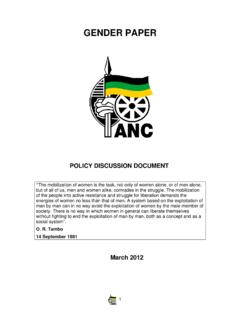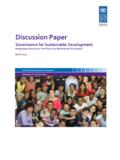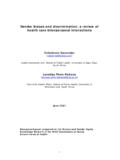Transcription of Results-Based Management Discussion Paper
1 Results-Based Management : TOWARDS A COMMON UNDERSTANDING AMONG DEVELOPMENT COOPERATION AGENCIES Discussion Paper (Ver. ) Prepared for the Canadian International Development Agency, Performance Review Branch, for consideration by the DAC Working Party on Aid Effectiveness and Harmonisation. Werner Meier, Director Results-Based Management Group Ottawa, Canada, RBMG @ Wednesday, October 15, 2003 Page iTABLE OF CONTENTS AN EVOLUTION IN Management ..2 PUBLIC SECTOR MODERN Management GOAL SETTING IN DEVELOPMENT RBM - WHAT IS IT? ..6 LANGUAGE AND KEY PRINCIPLES FOR PUBLIC SECTOR Partnership ..7 Accountability ..8 Organisational Learning ..8 Transparency ..8 Simplicity ..9 Flexible and Iterative Application ..9 RBM Management RBM: WHAT IT S NOT? ..10 CONTINUOUS COMPLIANCE AND PERFORMANCE- based PERFORMANCE ANNEX A: SIX BASIC STEPS TO MANAGING FOR results .
2 12 Draft RBM Discussion Paper Page 2 INTRODUCTION Background The first meeting of the DAC Working Party on Aid Effectiveness and Donor Practices held in Paris on May 19-21, 2003, acknowledged the importance of managing for results in order to enhance development co-operation effectiveness. It was agreed that further work should build on the international collaboration that began at the June 2002 Washington Roundtable on Better Measuring, Monitoring, and Managing for Development results and that an experts meeting should be organised to identify the scope of such work. As a first step, four bilateral agencies, , CIDA, DANIDA, DFID and Foreign Affairs/DGIS (the Dutch co-operation), agreed to commission a Discussion Paper by a reputable consultant with broad international experience who would present some of the most current thinking on Results-Based Management (RBM).
3 Purpose In accordance with the Terms of Reference provided to the consultant, the main purpose of this Discussion Paper was to address two questions, What is RBM? and What is it not? A secondary purpose was to identify some core principles to guide the development and implementation of poverty reduction strategies. Representatives of the four bilateral agencies expected that this Paper would generate extensive Discussion and debate on the concepts, principles and perspectives put forward, thus beginning an iterative process of dialogue and revision until some acceptable degree of consensus could be reached. A subsequent iteration of the Paper could elaborate more fully on the implications for donor agencies and developing countries alike when applying the RBM approach in the context of developing and implementing poverty reduction strategies. Structure This Discussion Paper begins with a brief overview of the confluence of factors that have shaped the RBM approach and then presents its defining characteristics, as well as six basic steps to managing for results (Annex A).
4 AN EVOLUTION IN Management Public Sector Context For more than fifteen years, there has been constant pressure on governments around the world for greater transparency and accountability by taxpayers for the use of public resources. Public concern in the face of escalating national account deficits, a declining confidence in political leadership and the need for a more transparent and accountable governance have all been important factors contributing to the emergence of RBM in the public sector. Several books have documented the emergence of this new public sector Management approach now prevalent in many OECD countries1. Historically, governments focused their attention on human, technical 1 For more details see Osborne and Gaebler (1993), Reinventing Government: How the entrepreneurial spirit is transforming the public sector and Peter Aucoin (1996), The New Public Sector Management : A Comparative Perspective.
5 Draft RBM Discussion Paper Page 3 and financial resources provided as inputs for their programs. The modern Management agenda calls for a major shift in focus where public service managers are expected to define expected results , focus attention on result achievement, measure performance regularly and objectively, learn from performance information, make adjustments and improve the efficiency and effectiveness of their programmes. However, implementation of the RBM approach in government has been incremental and not without its challenges and disappointments, which central agencies have aptly documented. Modern Management Approaches A brief overview of the advances in Management over the past forty years allows us to put the advent of RBM into perspective.
6 Public sector Management has evolved considerably since the Planning, Programming and Budgeting Systems (PPBS) approach of the late 1960 s with its emphasis on financial planning and cost accounting. The Management of inputs, , human resources, operating and capital costs was of paramount importance in demonstrating Management control over the allocation and use of financial resources. Programme Management By Activity (PMBA) became prominent in the 1970s and 1980s when donor organisations were heavily involved in physical infrastructure and industrial development projects. It combined several tools and techniques to plan and schedule activities, , Work Breakdown Structure (WBS), the Gantt Chart, Critical Path Method (CPM), Programme Evaluation and Review Technique (PERT). These conventional blue-print techniques emphasised the implementation of activities according to a planned schedule and were derived from the fields of construction engineering and systems Management .
7 Although it has a much earlier history, Management -By-Objectives (MBO) in the mid-seventies enjoyed a resurgence of enthusiasm in the public sector. It allowed managers to take responsibility for the design and implementation of a programme or project under controlled conditions by setting objectives and identifying performance indicators. It provided organisations with a modicum of control and predictability while still being able to delegate responsibility to individuals and teams. The most common application at the time was the Logical Framework Approach (LFA) used in the early seventies by the Agency for International Development (USAID). It has since been widely adopted and adapted by the international donor community and is used mostly as an analytic tool2 for project design and approval, while its potential for performance monitoring and evaluation have never been fully realised.
8 An alternative version referred to as Objectives-oriented Project Planning included standard procedures for participatory analysis, problem solving and objectives setting with partner organisations and target groups3. The diverse use to which the LFA has been put over the years is a testimony to the enduring strength of the approach. 2 Here we refer specifically to the sixteen-cell matrix, which is the product of using the Logical Framework Approach, and often referred to as the Logical Framework Analysis, logical framework, logframe or LFA. 3 Hailey and Sorgenfrei (2003), Measuring Success? - Issues in Performance Management . A Keynote Paper presented at the 5th International Evaluation Conference on Measurement, Management and Accountability? KDK Conference Centre, The Netherlands.
9 Draft RBM Discussion Paper Page 4 The new public Management in the 1980s led to widespread government efforts at becoming client and service-oriented, spawning the development of a multiplicity of quality service standards. A new wave of methods and techniques soon followed, including Quality Control/Quality Assurance, ISO Accreditation, Total Quality Management (TQM), etc. which, for the most part, focussed on service delivery processes, quality standards and the acceptance of goals for continuous improvement. Concurrently, a renewed interest in performance indicators arose to measure the efficiency and effectiveness of public service delivery, increase government control over quality, enhance accountability and improve client services. Over the decades we have seen a shift in the focus of public sector Management approaches from budgets, to activities, process controls, to objectives and now results .
10 Although the Australian government adopted it as early as the mid-1980s, managing for results became an increasingly important public sector Management theme during the 1990's. In an effort to demonstrate value for money in public services many of the OECD member states have reformed the way government does business by shifting their focus from inputs, activities and outputs to outcome achievement. Recent developments in information and communications technology have made integrated Management information systems possible, opening the door to capturing and processing large amounts of quantitative financial data, while analysing it in relationship to qualitative outcome data. RBM is clearly an evolution in Management and not a revolution, with its origins firmed rooted in the Management sciences and closely linked to previous efforts to implement the Management -By-Objectives approach.






